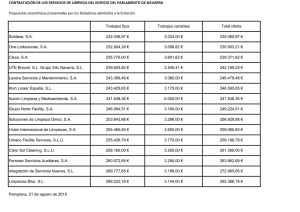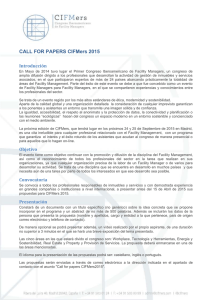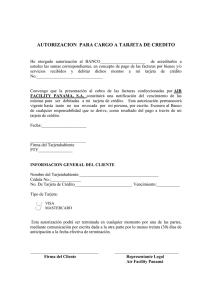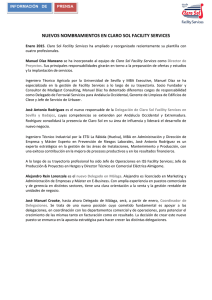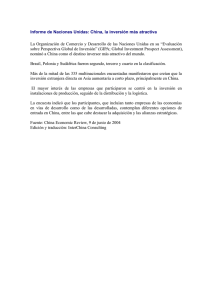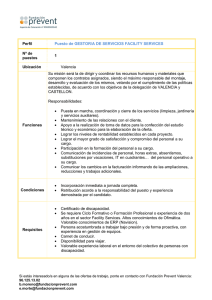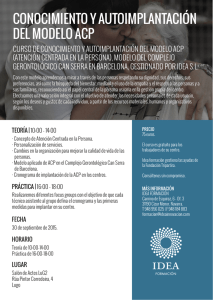ES ES DOCUMENTO DE TRABAJO
Anuncio
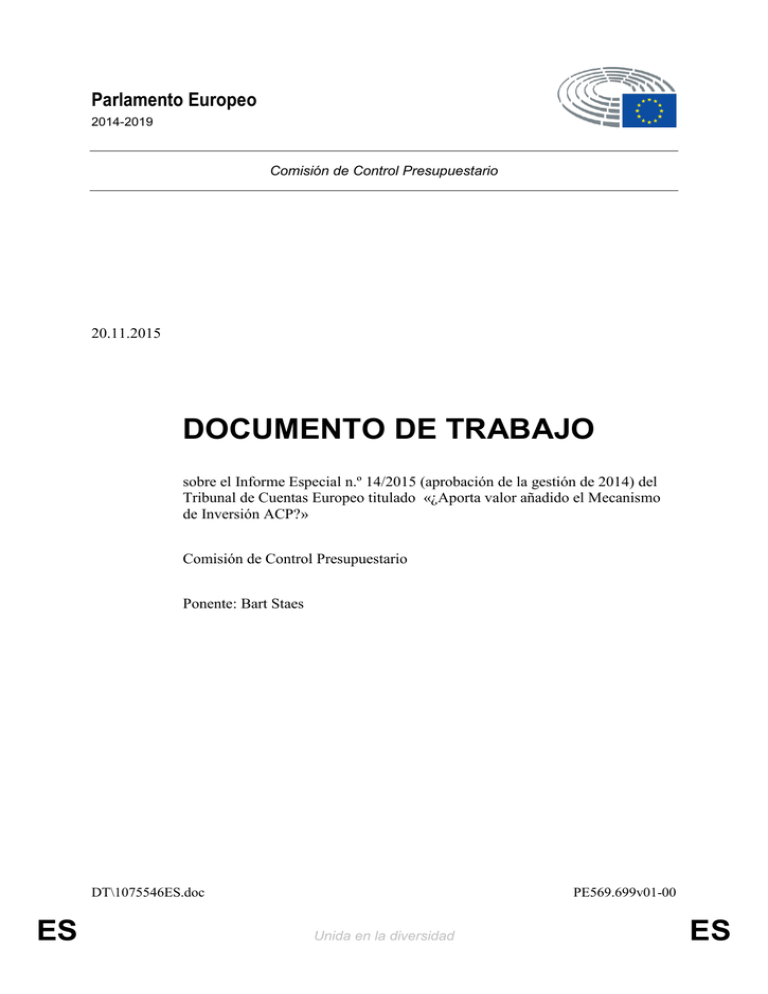
Parlamento Europeo 2014-2019 Comisión de Control Presupuestario 20.11.2015 DOCUMENTO DE TRABAJO sobre el Informe Especial n.º 14/2015 (aprobación de la gestión de 2014) del Tribunal de Cuentas Europeo titulado «¿Aporta valor añadido el Mecanismo de Inversión ACP?» Comisión de Control Presupuestario Ponente: Bart Staes DT\1075546ES.doc ES PE569.699v01-00 Unida en la diversidad ES Introduction The African, Caribbean and Pacific (ACP) Investment Facility was set up under the Cotonou Agreement and began operation in 2003 for a period of 20 years. The Facility’s overarching objective is to support investments by private and commercially run public entities in all economic sectors. It provides medium to long-term financing through various financial instruments and thereby aims at delivering sustainable economic, social and environmental benefits. The Investment Facility, which receives its capital from the 9th, 10th and 11th European Development Funds, is a risk-bearing revolving fund which is intended to be financially sustainable with a total endowment of 3 685 million euro. Capital contributions by the Member States are paid directly to the European Investment Bank (EIB), which manages the Facility, acting on behalf of the EU and outside the EU budget as the EDFs. The European Investment Bank complements the Facility's funding with its own resources. Under the 11th EDF, a replenishment of 500 million euro was allocated to the Investment Facility to be used as dedicated funding i.e. the ‘Impact Financing Envelope’ for operations with higher development impact. According to the Cotonou Agreement provisions and to generate value added, the Investment Facility has to operate on the local markets without creating market distortion to the detriment of private sources of financing, help the mobilisation of long-term local resources as well as attracting private investors and lenders. Audit Scope and Objectives The Court examined whether the Investment Facility’s added value to the EU’s development cooperation with ACP countries. The audit focused on the two following questions: - Are the Investment Facility’s operations coherent with other EU development aid provided to ACP countries? - Does the Investment Facility provide access to long-term financing as well as loans in local currencies, and does it generate a catalytic effect? For this audit, the Court used operations signed by the Investment Facility under EDFs funding between 2011 and 2014 as a basis for assessing whether the Investment Facility added value to EU development cooperation with ACP countries. Operations financed with EIB’s own resources were not included in the Court’s audit scope as they fall outside the Court’s remit, nor the very small funding provided to Overseas Countries and Territories (OCT). The assessment of the effectiveness of the ACP investment facility was not also included within the Court’s audit objectives. The Court’s audit work consisted of an analytical review, interviews with EIB and Commission staff, a sample of 20 operations funded by the Investment Facility and an audit visit in Kenya and Uganda. PE569.699v01-00 ES 2/6 DT\1075546ES.doc Court's Findings and Observations - Are the Investment Facility’s operations coherent with other EU development aid provided to ACP countries? The Court examination of the 20 operations selected showed that they were coherent with the EU’s development policy as broadly described in the Cotonou Agreement. The Court also observed that the Impact Financing Envelope (IFE) allowed the Investment Facility to support higher-risk projects which generate a strong development impact with the overarching objective of poverty reduction. The Court reviewed in particular the functioning of the project identification and selection and the funding arrangements. Project identification and selection With regard to the project prospection done by the EIB headquarters and its representatives in the ACP countries with the consultation of the EU delegations, the Court noted that the Commission had expressed favourable opinions in respect of all 20 operations under review by the Court. Funding arrangements Concerning the funding arrangements used under the ACP Investment Facility, the Court analysed the three instruments currently used i.e. credit lines to financial intermediaries, equity investments and direct investment in infrastructure projects. The Court observed that for the credit lines the EIB was working with financial intermediaries selected after due diligence checks assessing their past performance, future strategy and ability to lend to a wide range of SMEs as well as through an allocation procedure for checking the eligibility of end beneficiaries. The Court found however in Kenya that the contractual obligation to inform the end beneficiaries about EIB/Investment Facility funding was not always followed and that the financial intermediaries had not informed small and medium sized enterprises (SMEs) on the possibility to receiving various types of technical assistance in addition to the credit lines granted. For the management of equity investments which are used to foster financial inclusion, job creation and entrepreneurship, the Court found that the EIB was represented within fund advisory committees thereby allowing the EIB to ensure consistency with chosen strategies and alignment with EU development policy. As regards the third modality proposed by the EIB i.e. direct investment in infrastructure projects, the Court's review showed that all audited infrastructure projects were found to be coherent with other EU development cooperation measures. - Does the Investment Facility provide access to long-term financing as well as loans in local currencies, and does it generate a catalytic effect? The Court examined whether Investment Facility operations were providing added value through long-term financing provided to the private sector in local currencies and were having a catalytic effect by attracting complementary funding. DT\1075546ES.doc 3/6 PE569.699v01-00 ES Long term financing The Court observed that the ACP Investment Facility has increased its lending volume recently with credit lines representing end 2014 28% of the Investment Facility portfolio compared to 14% at the end of 2010, this trend demonstrating the importance given to this type of financing on the market offering. The audit work also revealed that the average length of loans to financial intermediaries was nine years, this being a good basis for more sustainable investments. Financing in local currency The Court noted that loans in local currency were higher during 2011-2014 both in volume and proportion of the total Investment Facility portfolio. End 2014, the amount lent in local currency represented 18.1% of the Investment Facility endowment. The initiative was welcomed by financial intermediaries in ACP countries both for avoiding the exchange risk for the final beneficiary and for its potential in terms of development impact. Catalytic effect From the audit work carried out on the 20 operations selected and information obtained from financial intermediaries and beneficiaries, the Court finally observed positive leverages ratios for the three financial instruments proposed under the ACP investment Facility, respectively 4.6 for infrastructure projects, 3.2 for credit lines and 7.1 for equity. More generally, the ACP Investment Facility demonstrated a positive catalytic effect by successfully mobilising longterm resources and attracting foreign private investors and other lenders to projects in the ACP countries. Court's recommendations The Court makes two recommendations designed to increase the added value provided by the ACP Investment Facility: 1. Systematic disclosure of the Investment Facility in on-lending agreements The EIB should make sure that financial intermediaries include a reference to the Investment Facility in their on-lending contracts so that end beneficiaries are informed about the source of the funding; 2. Proposing technical assistance to supplement credit lines In order to enhance the development impact at the level of SMEs, the EIB together with the financial intermediaries should ensure that the end beneficiaries are fully able to benefit from technical assistance; Recomendaciones del ponente para su posible inclusión en el informe anual de aprobación de la gestión de la Comisión [El Parlamento Europeo] 3. Acoge con satisfacción el informe especial dedicado al valor añadido del Mecanismo de Inversión ACP como un ejemplo concreto y positivo de seguimiento por el Tribunal de los PE569.699v01-00 ES 4/6 DT\1075546ES.doc procedimientos de aprobación de la gestión 2012 y 2013, en los que el Parlamento le había solicitado que elaborara un informe especial sobre la eficacia de los préstamos exteriores del BEI y su coherencia con las políticas y los objetivos de la Unión en el ámbito del desarrollo antes de proceder a la revisión intermedia del mandato exterior del BEI y a la evaluación intermedia del Mecanismo de Inversión; 4. Considera que la inclusión de una auditoría del Mecanismo de Inversión ACP en el plan de trabajo del Tribunal de Cuentas es un ejemplo de buenas prácticas de cooperación y colaboración en las tareas de control ejercidas por el Parlamento y el Tribunal; 5. Considera que este informe de auditoría representa un paso importante, dado que se trata de la primera llevada a cabo por el Tribunal en este ámbito concreto; lamenta que el Mecanismo de Inversión no incida en el ámbito de aplicación de la auditoria de la declaración anual de fiabilidad del Tribunal; 6. Toma nota de las conclusiones positivas con respecto a la coherencia del Mecanismo de Inversión ACP con los objetivos de la política de desarrollo de la Unión y su efecto catalizador; celebra la buena cooperación entre el BEI y la Comisión, en particular en materia de prospección y selección; 7. Lamenta, no obstante, que el Tribunal no haya podido determinar con mayor precisión el valor añadido aportado por el Mecanismo de Inversión ACP; le pide, por tanto, que en sus futuros informes especiales ofrezca más ejemplos concretos y seleccione algunos proyectos que ilustren mejor sus conclusiones y recomendaciones; insta al Tribunal a que aproveche esta primera experiencia para perfeccionar los medios de evaluación del efecto de apalancamiento, el efecto catalizador y el valor añadido de este tipo de mecanismos; pide, asimismo, al Tribunal a que examine el valor añadido desde una perspectiva más amplia que integre el triple factor de la ecología, la igualdad y la ética, más que a partir del enfoque clásico basado en la economía, la eficiencia y la eficacia; 8. Coincide con las recomendaciones del Tribunal; pide, por tanto, a la Comisión que tenga en cuenta las recomendaciones del Tribunal en sus futuras propuestas legislativas y negociaciones, como la revisión del mandato exterior del BEI o el acuerdo posterior a Cotonú; 9. Recomienda por tanto que, en aras de la coherencia política de la Unión, se proceda a adaptar rápidamente el Mecanismo de Inversión y la política del BEI a los resultados de la COP 21 y a los posibles ODM después de 2015; considera que debe concederse una prioridad todavía mayor a la lucha contra el cambio climático y a todas sus consecuencias directas e indirectas, especialmente en los países más pobres del mundo; 10. Considera fundamental que el BEI siga invirtiendo tiempo en la política de debida diligencia asociada a mecanismos de evaluación que permitan mejorar el conocimiento del perfil de los intermediarios financieros y los beneficiarios, así como la evaluación de la incidencia de los proyectos en los beneficiarios finales; insta al BEI a que asuma con seriedad las recomendaciones del Tribunal y mejore las prácticas en vigor con miras a reforzar el valor añadido del Mecanismo de Inversión ACP; 11. Considera que todos los gastos financiados con dinero de los contribuyentes de la Unión deben someterse sin ninguna excepción al procedimiento de aprobación de la gestión por DT\1075546ES.doc 5/6 PE569.699v01-00 ES el Parlamento; reitera y cree firmemente, por tanto, que el Mecanismo de Inversión gestionado por el BEI en nombre de la Unión debería estar sujeto también al procedimiento de aprobación de la gestión por el Parlamento, dado que se financia con dinero de los contribuyentes de la Unión; 12. Señala que el acuerdo tripartito a que hace referencia el artículo 287, apartado 3, del Tratado de Funcionamiento de la Unión Europea, por el que se rige la cooperación entre el BEI, la Comisión y el Tribunal de Cuentas con respecto a los métodos de control aplicados por el Tribunal sobre la actividad del BEI en la gestión de los fondos de la Unión y de los Estados miembros, debe somerterse a revisión en 2015; reitera su opinión de que es oportuno actualizar en este sentido el ámbito competencial del Tribunal de Cuentas Europeo, de forma que incluya todo nuevo instrumento financiero del BEI que implique la asignación de fondos públicos de la Unión o el FED. PE569.699v01-00 ES 6/6 DT\1075546ES.doc
